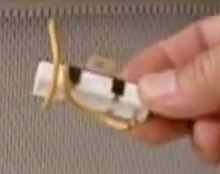Microwave Oven is an essential part of modern days kitchen not only in developed countries but also in many developing countries.Like many other electrical home appliances,microwave ovens are also liable to develop some minor or major faults over the period of time as they are used in routine.In this article some techniques to repair a faulty microwave oven are presented.
Components and Items Required for Troubleshooting :
For troubleshooting a microwave oven you may need the following components and tools:
Fixing Problems :
To fix the problems with Microwave Oven,first unplug its power cord from power receptacle and the remove its cover by unscrewing the screws on the top and sides of the backside of the Microwave Oven.Also look out for the screws at the bottom if there are any on Microwave Oven for opening the cover.
After unscrewing the screws of the Microwave Oven cover grab the cover and slide it back a little then tilt it up and pull the cover to remove it.If you want to put the cover back you can do the reverse.
The inside of a microwave oven with cover removed is shown in the Figure 8 below.
There is an internal resistance for this capacitor that bleeds off the voltage when the microwave oven is unplugged from power receptacle but as a safety precaution is advisable to discharge this capacitor before repairing the microwave oven otherwise it could be lethal.
Components and Items Required for Troubleshooting :
For troubleshooting a microwave oven you may need the following components and tools:
Figure 1 : A Typical Microwave Oven
- A Digital or Analog Multimeter. However,it is better to use a digital one.
Figure 2 : A Typical Digital Multimeter
- Some jumper wires preferably with crocodile clips as shown in Figure 3.
- A Phillip and a Flat Screw Drivers.
- A 20K Ohm Ceramic Resistor like the one shown in Figure 5 below. The wattage rating of this resistor should be atleast 5Watts.You can choose 5W,10W or even higher rated Ceramic Resistor.If 20K resistor is not available you can use a lower value resistor but not less than 1K Ohm but preferably not less than 5 Watts.
- Electric Voltage Tester as shown in the Figure 7 below or any other electric voltage digital tester
- No Power to Microwave Oven : Check with a tester or by plugging in another appliance into the Receptacle whether it is providing power to the appliance plugged into that receptacle.
- No Hum is Heard When Powered Up: When you power up your Microwave Oven and turn it on you see the light inside the Microwave Oven chamber and also see the turn table spinning around but you do not hear the humming sound of the Transformer for the Magnetron that you hear when a fully operational Microwave Oven is run for heating any food item.
- Food Does not Get hot Enough : Microwave Oven does not heat the food to enough temperature that a fully operational Microwave Oven would do.
- Circuit Breaker Trips : The Circuit Breaker trips when you push the start button on Microwave Oven.
Fixing Problems :
To fix the problems with Microwave Oven,first unplug its power cord from power receptacle and the remove its cover by unscrewing the screws on the top and sides of the backside of the Microwave Oven.Also look out for the screws at the bottom if there are any on Microwave Oven for opening the cover.
After unscrewing the screws of the Microwave Oven cover grab the cover and slide it back a little then tilt it up and pull the cover to remove it.If you want to put the cover back you can do the reverse.
The inside of a microwave oven with cover removed is shown in the Figure 8 below.
Figure 8 : Inside view of a Microwave Oven
In Figure 9 you can see a High voltage Capacitor.This contains dangerously high voltage of about 2000Volts.Before touching any component in the inside of the microwave you need to first discharge this capacitor otherwise it may be lethal to repair microwave oven.
Figure 10(a) : Discharging High Voltage Capacitor
Figure 10(b) : Discharging High Voltage Capacitor
Figure 10(c) : Discharging High Voltage Capacitor
Figure 10(d) : Discharging High Voltage Capacitor
Figure 10(d) : Discharging High Voltage Capacitor
To discharge the capacitor you need a Ceramic High Wattage Resistor connected with two wires and two crocodile clips connected with wire ends.Connect one crocodile connector with the screw driver as shown in Figure 10(b). Connect the other crocodile connector with Ground Screw on the Chassis or any other suitable bare metal part.When wires are connected this way touch each terminal of the capacitor with screw driver and hold it touching each of the terminals for atleast 10 seconds one by one so that the capacitor gets fully discharged.When you are done with this process to make sure that capacitor is fully discharged remove the crocodile clip from the chasis of microwave oven 















No comments:
Post a Comment